Curly flowers
Nature has provided man with a huge selection of climbing perennial plants for summer cottages, each of which is distinguished by its beauty and exoticism. All representatives of this category have resilient flexible stems, most of which require support. Novice gardeners are advised to opt for more unpretentious species.
Greening and decorating roads, balconies, fences and gazebos, they perfectly hide all construction errors. We invite you to find out the necessary information and see photos of beautiful curly flowers in the country.
Climbing rose is the result of breeding work on crossing garden and wild types of roses. This species has arcuate, whip-like shoots with small, hard foliage that require rigid support.
Large inflorescences of small flowers (no more than 5 cm in diameter) exude a delicate pleasant aroma and give aesthetic pleasure for 30-40 days, usually once a year. However, there are varieties with re-flowering. Depending on the variety, the flowers are red, pink, salmon pink, yellow and white. Plants are very whimsical, especially the first year. They really need abundant regular watering, sunlight and insulation during the cold season.
Wisteria is loved by experienced gardeners and novices alike. It belongs to deciduous lianas and its main decorative feature is the openwork foliage that falls to the ground. Unusually beautiful brushes of flowers, reaching 50 cm in length, cannot fail to attract the attention of even the most sophisticated aesthetes. Wisteria is very demanding on climatic conditions and needs to be pruned 2 times a year.
Maiden grape is a branched tree-like liana, the length of which reaches 20 m. Due to the complex structure of tendrils and suckers on them, grapes are easily fixed on any surface and does not require additional supports. The main aesthetic value of the plant is its luscious green foliage, which changes its color to purple and red with the onset of cold weather. Small fruits also look very decorative and remain on the branches until the leaves are completely shed. The plant grows quickly, is not demanding in terms of care and place of growth, frost-resistant.
Honeysuckle is a climbing shrub, reaching a height of 2-3 meters. It requires regular pruning and tying. The flowers of the plant have a unique aroma, and the dark blue fruits of some species have valuable medicinal properties. It is a very unpretentious culture and grows in any climatic and landscape conditions.
Perennial plants for summer cottages have very diverse shapes, shades and flowering periods (from early spring to frost). A competent combination of various perennial crops in landscape compositions will allow you to enjoy the variety of colors and aromas throughout the garden season, making the garden unique and exquisite. A dacha filled with constantly flowering plants can become the pride of any grower and the guarantee of a great mood.
1decor.org
- Climbing plants for summer cottages
- Climbing plants for summer cottages
- Climbing plants for pergolas
- Climbing plants for the garden photo
- Climbing plants for pergola
- Ornamental non-flowering plants for the garden
- Climbing plants pergola photo
- Climbing plants
- Climbing ornamental plants
- Climbing plants on the balcony
- Climbing annual plants
- Curly annuals for the garden
- Curly annuals photo
- Coniferous plant varieties for the garden
- Salads for giving
- Drip irrigation for summer cottages
Shade-loving climbing plants for the garden. Shade-loving flowers - species
Several types of popular shade-loving garden flowers:
- anemone oak tree (anemone) - "messenger of spring". It blooms for 20 days - from April to the end of May (depending on planting it in the ground);
- lily of the valley (goes well in planting with anemones);
- big astrantia - perennial plant (its height is from 40 cm to 1 m, flower up to 5 cm);
- crested hollow - flowering occurs from the beginning of spring;
- dicentra - reach up to 1 m in height, flowering begins in May and ends in early June;
- foxglove - a two-year-old flower, beautiful from June to August, plant height reaches one and a half meters;
- geranium (geranium bloom occurs from one to one and a half months);
- liverwort - a low plant (from 5 cm to 15 cm), in the form of flowering it resembles a human liver, hence the name;
- hosta is a long-liver in the garden, can grow up to 25 years old, grows slowly, and blooms in August;
- fern.
Also, in any shade, all primroses bloom perfectly and grow for a long time. They can be sown directly under the tree, and if there are seedlings, they can be immediately planted with bushes.
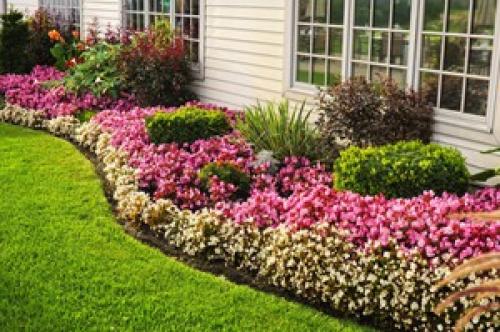 They love the shadow of the violet. Violet is a low fragrant flower that blooms twice a year (April-May) and in autumn.
They love the shadow of the violet. Violet is a low fragrant flower that blooms twice a year (April-May) and in autumn.
Shade-tolerant beauty - kupena (fragrant, graceful) is a very rare plant in our gardens and vegetable gardens, but she did not deserve it. This is a very beautiful flower that blooms with white bells in the first half of summer. And no flower can interrupt his smell. Its advantage: it can grow and reproduce in full shade. Reproduction takes place by seeds or roots. Moisture-loving plant. Propagated by root cuttings in spring. As soon as the flower fades, the aerial part dies off.
For shady corners, astilbe is suitable. It blooms from the beginning until the end of summer with small inflorescences of different colors - cream, white, pink and all red shades. A moisture-loving plant, in dry weather requires abundant watering. For the winter, the stems are cut, and the roots are covered with dry foliage. Its growth buds are located close to the soil surface, and therefore it should be protected from frost.
Daylilies and hemerocalis can withstand a little shade; they love fertile soil and moisture. Currently, hybrids have been bred with their multi-colored colors - from white to almost black.
Popular perennial climbing plants
The best and most popular varieties and hybrid forms of climbing crops among flower growers are favorably distinguished by their unpretentiousness, winter hardiness, rapid growth and resistance to unfavorable external factors. Such plants can be flowering or decorative-deciduous, which allows you to choose the best option for landscaping.
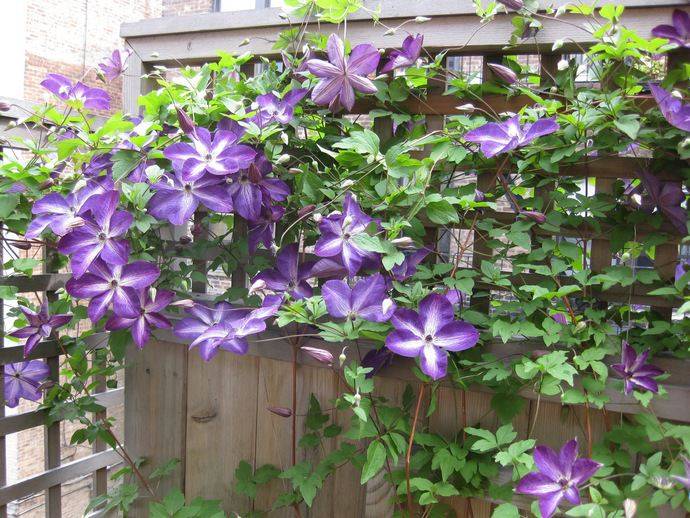
|
Name |
Feature and Description |
|
Climbing roses |
The advantages are represented by a rich color palette, abundant and long flowering, undemanding care, sufficient drought resistance. For the winter period, it is recommended to remove from the support and cover |
|
Clematis |
Purple, pink, white or blue flowers go very well with most ornamental plants. Growing involves the use of supports and competent regular pruning of the aboveground part |
|
Honeysuckle |
Curly perennial grows very well even in shaded areas. Forms relatively small, fragrant flowers, collected in attractive inflorescences |
|
Ivy |
A very unpretentious and viable climbing plant, the main advantages of which are the ability to braid any type of surface, rapid growth and resistance to unfavorable soil and climatic conditions |
|
Maiden grapes |
The perennial becomes a real decoration of pergolas, gazebos and fences from early spring to late autumn, but it needs systematic pruning, which is due to the tendency to excessive thickening |
|
Actinidia |
Winter-hardy flowering and fruiting liana, perfect for landscaping backyard areas in the northern regions. Very flexible stems require vertical support |
|
Wisteria |
The liana-like plant of the "Blue Moon" variety has an amazing frost resistance and forms beautiful red or blue flowers. Used in the design of gazebos and verandas, as well as pergolas and arches |
|
Hop |
Herbaceous type dioecious plant, climbing upward in a clockwise direction, has opposite palm-like foliage and interstitial stipules |
|
Aristolochia |
Herbaceous perennial with smooth erect or curly shoots. These woody vines are great for backyard landscaping and bold landscape solutions. |
|
Bougainvillea |
A braiding light-loving tropical perennial plant that needs to be grown only in brightly lit areas |
List of the most beautiful perennials
Perennials are good because there are a lot of their varieties. But this is also a kind of minus, because it is very difficult to choose several types from such an assortment.
Therefore, to make it easier for you, we have compiled our list of the most beautiful and often planted perennials.
Adonis is a very beautiful flower, it has two types of color - red and yellow, the flowering period is from May to June. Try to transplant it in the rare case, it grows slowly, winter-hardy.
Kalistegi - refers to perennial climbing flowers for summer cottages, reaches up to 4 m in height, is winter-hardy, has pink flowers, blooms from late June to the end of the season, until the first frost. It is better to prepare the soil for this type of perennials in the fall, but planting should be carried out after the final warming up of the soil - in May.
Colchicum - blooms late - in the fall. It looks like a very delicate flower, but is actually poisonous. If you decide to plant it on your site, then wear gloves when planting and other care, since even the water in which it is located becomes poisonous.
Cornflower - a large selection of flowers, blooms from late June to August, single flowers. Such flowers love the sun, frost-hardy, tolerate drought well.
Gazania is very bright and eye-catching, there are about 40 species of such plants. At night, the flower curls
Drought-resistant, does not like too wet soil, for the winter it must be transplanted into a box and stored in a warm room, since it can only withstand frosts down to -5 degrees.
Lily of the valley - blooms with white flowers in May - June, flowers are like bells, loves moisture, frost-resistant, loves partial shade.
Euphorbia - blooms from May to July, it comes in the form of both a shrub and a tree, flowers are yellow. Drought-resistant, can grow in the sun and in partial shade, winter-hardy.
Muscari - blooms in April - May, there are several types, the color depends on the type of plant. They do not tolerate strong moisture, drought-resistant, winter-resistant, can grow both in the sun and in partial shade.
Narcissus - there are more than 60 varieties, blooms from May to June, it is better to plant in places where there is a lot of sun, it will grow better there, although the plant will also take root in the shade.
Clematis - there are more than 230 species of such plants, of all, terry is distinguished. It blooms from June to the first snow, the fullest flowering occurs only in the 3rd or 4th year.
Delphinium - there are more than 400 varieties of such plants, blooming from late June to August. Does not tolerate moisture, it is necessary to plant in those places where there is the least amount and strength of wind.
Aster - flowers from the lightest to darkest colors, bloom from September until the first frost. Loves the sun, drought-resistant, frost-resistant.
Here is a small list of the most beautiful and graceful flowers.
.
Unpretentious perennial climbing plants for the fence
A well-groomed and beautiful garden is always pleasing to the eye and raises the self-esteem of its owner. However, an old fence or unsightly agricultural buildings can ruin the whole impression of the site.Therefore, many gardeners try to use unpretentious perennial climbing plants for the fence in order to hide all possible design flaws and add a little cool shade for a hot summer.
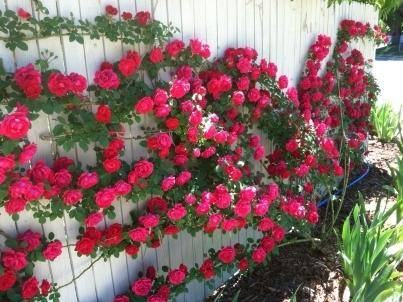
The choice of plants and their functions in the garden
Since the site can be decorated in absolutely any style, flowers and shrubs are selected according to the general idea. These can be additions to classic, oriental, ecological garden designs and many others. Conveniently, despite the chosen style, the climbing plants for the fence, perennials and annuals, are almost always the same. To select suitable vines or shrubs, you need to decide on the purpose of this type:
- Camouflage function. Perennial climbing plants for the fence are always designed to decorate unsightly exterior details: barrels for collecting rainwater and compost, unsightly sheds or old dying trees that cannot be uprooted in any way.
- Decorative function. Mostly decorated with fences and low buildings.
- Covering function. Densely growing perennial climbing plants for the fence are planted to create pleasant coolness for people and a saving shade for various representatives of the flora in the garden or summer cottage. They are rooted around fences, gazebos, and open areas for recreation. Even light rain is easy to wait out under the hood of climbing plants. Many gardeners hide their plots from prying eyes in such a simple way, and thorny shrubs, such as curly blackberries, will also reliably protect them from those who want to eat other people's vegetables and fruits.
Creeping shrubs and vines are able to visually increase the total area of the garden or summer cottage due to the multi-level structure and the play of shades of green. The climbing plants for the fence, photos of which can be seen in this article, are ideal for latitudes with temperate and continental climates.
Perennials for the garden
The most common and attractive representatives of the climbing flora are roses. Clematis are also considered popular - they are easy to grow, they have a huge range of colors and shapes that suit any design. Edible honeysuckle will allow you to stock up on healthy berries and hide the shabby pieces of the old fence. It will be possible to make drinks and special hair masks from traditional hops, so gardeners are happy to plant this shrub along the wattle fence or walls of buildings.
Inedible, but very attractive decorative grapes twist well and practically does not require watering and fertilization. Once or twice a year, you will need to shape your green "bedspreads". Perennial climbing plants include a huge list of suitable candidates, so a simple plan should be followed for optimal selection:
- You need to choose a design style.
- Plants are selected according to the color scheme and the possibility of joint arrangement on the site.
- Perennial loaches are planted in designated places.
Tip: creeping roses and blackberries are quite thorny plants, so you should not fill the space around gazebos and fences with them, where active life is taking place or children are running around.
.
Long-term joy: compositions from perennial vines
Gardeners often plant perennial curly flowers. They grow for decades if the care is right. The most demanded ones:
- clematis;
- wisteria;
- Kampsis;
- honeysuckle;
- girlish grapes;
- climbing roses
- ivy.
Clematis
Clematis is a charming vine with large flowers, powerful roots, entwining gazebos, arches, verandas. It grows all over the world, there are more than 200 of its species, a dozen of them are grown here. Simple and double clematis flowers of various shades:
- blue,
- red;
- lilac;
- white;
- purple;
- blue;
- cherry;
- beige.
Care consists in loosening the soil. We need spring feeding with urea (a tablespoon per bucket of water), closer to autumn, the liana requires complete mineral fertilization. An adult bush is watered abundantly three times a week - up to two buckets of water.
Propagated by cuttings, dividing the bush, layering. The easiest way is to cut the cuttings with knots from the middle of the shoot. They do this in early summer. The cuttings are planted in the ground, covered with a jar on top in the shade until the roots appear.
Clematis is transplanted to a sunny, windless place. Liana does not like acidic, moist soil; drainage is needed. The transplant takes place in spring or autumn. Compost and mineral fertilizers are added to the soil. The vine grows quickly. Before winter, the soil is loosened, the shoots are cut off, a knotty stump remains, it is covered with soil by 10 cm. The plant is frost-resistant, cold -35 is not terrible, it also tolerates heat well.
The flower suffers from infectious diseases, begins to fade. Withered shoots are destroyed, the plant and the soil are treated with a copper-soap emulsion. Prevention of fungal diseases is carried out by spraying the shoots with foundationol (10 liters 20 g).
Many pests are dangerous for clematis - spider mites, aphids, bears, mice, caterpillars, snails. The roots are damaged by small worms - a nematode, the plant dies. The method of dealing with a nematode is planting a number of calendula, parsley, marigolds, dill.
Wisteria
Wisteria is a luxurious southern perennial native to eastern countries. Interesting by hanging half-meter brushes of blue, pink, lilac color.
Campsis
Campsis is a magnificent perennial that decorates fences, trellises, arches. Its bright flowers - orange, yellow, red - delight the eye.
Honeysuckle
Honeysuckle is a liana-like plant with inedible fruits that looks great in garden plots, thanks to its decorative features - abundant flowering, dense foliage, and a wonderful aroma.
Maiden grapes
Girlish grapes decorate walls, fences, verandas. Easily propagated by cuttings, layering. It is adored by gardeners, it is unpretentious, it grows rapidly, winding around large areas.
Climbing roses
Climbing roses clearly claim to be a king among the entwining garden favorites. Their beauty, aroma emanating from arches entwined with them, gazebos fascinate. A variety of shapes, colors allows you to make wonderful compositions.
Ivy evergreen
Ivy is evergreen, intertwining the surface grows wherever it is planted. Care consists in watering, the soil must be moist. Forms luxurious thickets, can easily completely entwine the building.
Curly perennial flowers
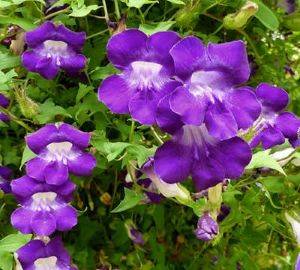
Azarina
A typical perennial up to 3.5 m high, loves warmth and light. It has a beautiful stem with extensive branching. The peak of attractiveness comes during the flowering period, when large white, pink, purple or blue flowers look great against a backdrop of velvety green foliage.
Aconite curly
On slightly twisted stems, rarely growing in height above 2 m, flowers of various shades can flaunt - blue, lilac, purple-blue, white with a purple bloom. Prefers partial shade and soil with moderate moisture. Withstands frost well.
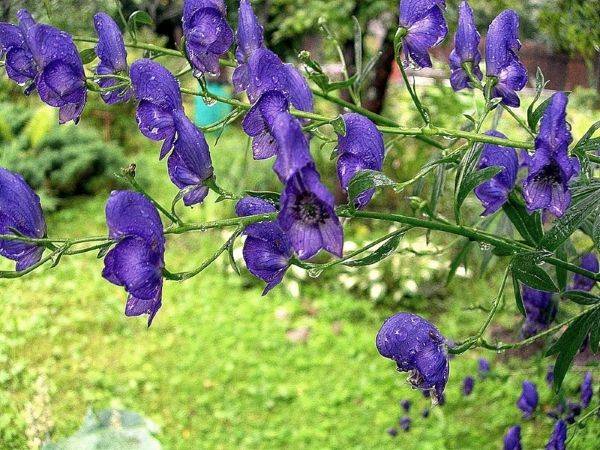
Stalked hydrangea
A very showy flower plant. Over time, it can completely hide the gazebo or veranda under an exotic vertical carpet of bright juicy flowers. Ideal crop for planting in areas with fertile and acidic soils.

Honeysuckle honeysuckle
This vigorous perennial (up to 6 m and above) amazes with its amazing flowers. Filling the whole garden with a heady aroma, honeysuckle pleases with a stunning variety of pink, red, purple flowers.
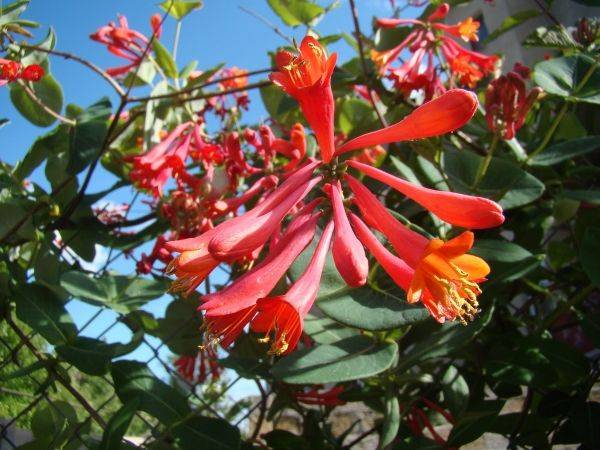
Clematis
They are loved by gardeners for their fast growth, long flowering time and large bright flowers.They can be either one-color or two-color (white-pink, yellow-lilac, etc.). They prefer illuminated, windless areas on fertile soils.
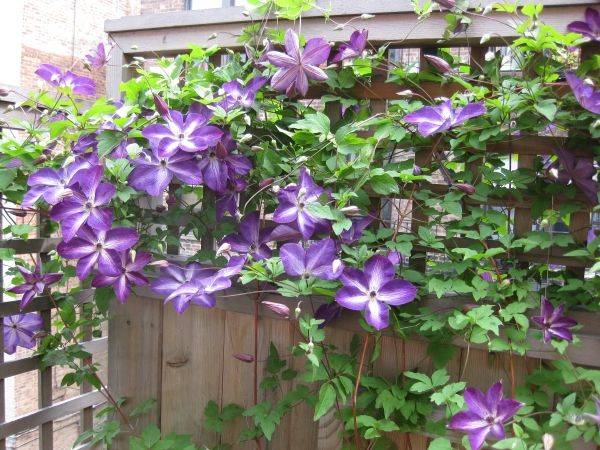
Princes
These tall, 3 m high and above, long-livers (live up to 20 years) are distinguished by a very unpretentious attitude to soil quality and irrigation, frost resistance and attractive flowers. Pleasing with a rich range of juicy shades

Climbing rose
A very popular vertical gardening option. It is divided into two varieties - plants that bloom once a season, but very abundantly, and individuals that bloom less densely, but twice a season.
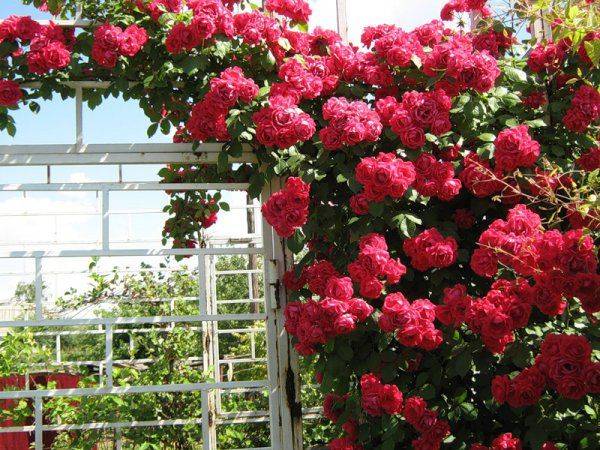
Wisteria
An unusually beautiful plant with flowing openwork leaves and magnificent long (up to half a meter) flower clusters. Disadvantage: rather capricious, does not tolerate frost well. Requires pruning twice a year.
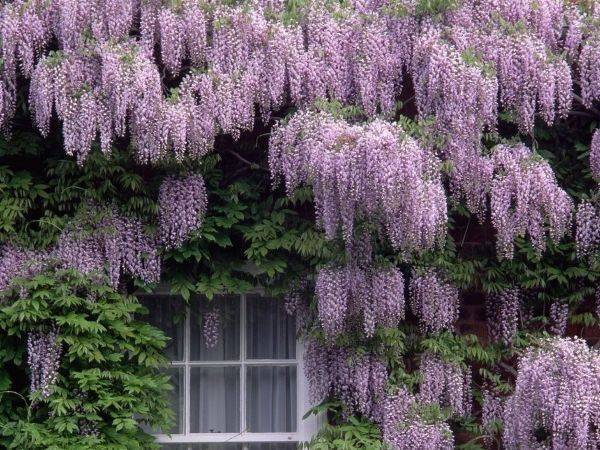 You may also be interested in an article on preparing perennials for winter and methods of protecting plants from the cold.
You may also be interested in an article on preparing perennials for winter and methods of protecting plants from the cold.
And how to properly grow aster seedlings, you can read here.
Choosing climbing plants for a summer residence: tips and tricks
Climbing plants are in a special place among the variety of horticultural crops. For summer cottages, this is the best option for creating hedges, decorating pergolas, garden arches and other architectural details.
Annual climbing plants for summer cottages
Fire red beans (Turkish beans) are a biennial that is commonly used as an annual. The flower grows very quickly, forming a dense and lush wall of fresh greenery with bright flowers. It is necessary to plant it when there is no longer a threat of frost, since the plant belongs to the thermophilic species.
Everyone is familiar with the aroma of sweet peas, which delights summer residents throughout the summer season. It can be planted both as seedlings and seeds. The plant is frost-resistant, prefers sunny places and needs intensive watering.
The most common climbing plants for the home are bindweed (morning glory), also called gramophone. Morning glory is sensitive to frost and loves sunny places. Its multi-colored flowers bloom only for one day, then they wither, and in the morning new gramophones bloom.
Among annuals, such vines as decorative pumpkin, nasturtium, echinocystis, kobei, and so on, look great and do not require special care. But for more experienced gardeners, it is preferable to use perennial climbing plants for summer cottages. From them, you can create permanent landscaping in the areas allocated for this. These vines require special care, especially in preparation for wintering (they need to be covered).
Perennial climbing plants for summer cottages
Wisteria is a perennial that can rightfully be called the most luxurious vine. Its delicate lilac fragrant and lush inflorescences fall in whole clusters. But the flower is too sensitive to low temperatures, and takes root mainly in the south.
Clematis is another excellent perennial species. Its beautiful star-shaped flowers can be white, burgundy pink or deep purple. This is a great decoration for a gazebo, garden arch or pergola. Clematis begins to bloom in early June and ends in September. But there is one condition for its growth: the foliage needs the sun, but the soil at the root and stems should be in the shade. The flower tolerates heat easily, and the harsh winter can not withstand, therefore, for the winter, the plant is removed from the support and covered.
Ivy is a tree-like, unpretentious perennial. This evergreen liana with its dense green foliage can decorate any structure in the summer and autumn periods, while easily tolerating frosts.
Climbing roses are the most popular climbing perennials that do not require any special care, it is enough to plant the bush correctly and water it well. But when buying a plant, be sure to ask about its frost resistance, there are varieties that need sheltering for the winter.
Honeysuckle is an unpretentious, fast-growing perennial that feels great even in the shade. Its inflorescences consist of two-colored small flowers that give off a fabulous scent.And if you need a beautiful and fragrant wall, then honeysuckle is the most suitable option.
.
Types of climbing plants
All plants of this type can be conditionally subdivided into several groups, for example, flowering or growing without flowering, annual or perennial, tree-like or herbaceous, as well as differing in the ability to "master" the height. Among the latter group, there are such plants:
- creeping, who need support. But usually such loaches are planted to decorate small plots of land;
- climbing, perfectly doing without additional help and supports. With the help of their suction cups, they confidently grow to the top, clinging to all suitable supports;
- clinging, which need special supports and pillars. They produce special tendril-stem processes that firmly enclose the supplied supports.
